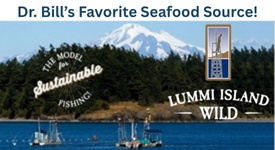Are wild fish from oceans and lakes more or less nutritious than farm-raised fish? Let’s go fishing for some facts.
As health-conscious American consumers have turned from meat to fish, the demand for fish has outgrown the supply. Some waters have become less, shall we say, fishy. In some parts of the world, populations of certain kinds of fish have been depleted, and fish prices have jumped sky high. One solution to the supply problem is to grow fish in “farms” where conditions are controlled and ecological conditions are not upset by overfishing. Fish on farms are raised in pens filled with water and are fed factory-made fish food. Fish farming has brought down prices for some kinds of fish and made fish supplies steadier and more dependable.
- a higher level of omega 3 fatty acids,
- a lower level of total fat
- no chance of containing antibiotics
- perhaps fewer pesticides and environmental pollutants (in ocean fish, not necessarily in lake fish)
Benefits of farm fish include:
- lower cost
- more control over the purity of the water, so they may have a lower level of pollutants
- more control over flavor and quality. A farmer can cater to specific tastes (so-called “designer fish”)
- an ecological alternative to depleting fish populations in certain already over-fished waters
The jury is still out on whether or not wild fish is healthier and safer than farm fish. So, it’s back to using your common sense.
A tale of two fish–one from the oceans of Alaska, the other from the farms of Alabama. Both are salmon–my favorite fish. The Alaskan salmon is spawned in a very fast moving fresh stream, the source of which is usually the meltdown of tons of snow and ice. In order to survive, the baby salmon must fight the raging waters and make its way out to the sea where she finds a healthy diet of seaweed. The seaweed is rich in brain-building fatty acids, which is why it is known among fishermen as nature’s antifreeze, a nutrient that allows the seaweed to grow in such frigid waters. The little salmon becomes a big salmon and becomes bigger by eating little fish that are also rich in omega 3 fatty acids. Over an average of four years, that salmon travels thousands of miles, spending winters in the warmer Pacific and summers in Alaska. The combination of a healthy diet and exercise builds a healthier fish, containing healthier oils. Once that little salmon becomes a big salmon, following one of nature’s most fascinating, yet least understood, homing instincts, the fertile fish navigates back to its original birth place, fights her way upstream past the raging waters to deposit her eggs and spawn more salmon. Soon after spawning she dies, a martyrs death. For that little fish to survive such a life cycle, that is one smart and healthy fish.
Contrast this natural fish cycle with the little salmon in the farm fish tank. That fish doesn’t have to battle predators and raging waters to survive. Nor does he have to swim much to search out for food. The farm fish just has to swim and eat, the equivalent of a couch potato. So, it stands to reason that the muscle and the oil in that fish will be chemically, and therefore nutritionally, different – sort of like the nutritional superiority between free-range chicken (and their eggs) and caged birds. And the farm fish’s food is chosen by the farmer instead of the fish, and it is unlikely that the fish farmer will buy expensive DHA-enriched fish food. The wild fish gets a healthier menu.
Fish just do not grow as fast in a pen as they do in the wild. (Keep a goldfish in a bowl and it stays a tiny goldfish. Take that same fish and put him in a backyard fish pond and that fish will grow.) This slow-to-grow fish will, however, be pushed to grow more quickly so he can go to market as soon as possible. Enter the fish-fattening chemists, who may give him fish-building steroids or other growth-boosting chemicals. Antibiotics may be added to the feed to keep the fish healthy, and the water will be filtered to keep the fish cleaner. Clearly, this fish will be different from the one that lived in the wild.
But deciding whether the wild fish is always the healthier fish is not so simple, especially because of pollutants and chemicals. For example, wild fish caught near the industrial areas of the Great Lakes may contain a lot more pollutants than closely monitored farm fish. Fish caught in smaller lakes that collect agrochemical runoff may also have high levels of pollutants. On the other hand, high pesticide residues have been discovered in commercial fish foods, and farm fish may be raised in pens filled with the same polluted waters that are home to the wild fish. True, both farm fish and wild fish are “regulated and inspected,” and the FDA routinely samples commercially-caught and farmed fish for pesticide and hormone residues to see “if limits are exceeded,” but not every fish that goes to market is inspected. And, who decides what is the “safe” or “tolerable” limit of pesticide, antibiotic, and hormone residues? There’s much we don’t know.
What’s a health conscious fish-eater to do?
- Consider the source. Ask your fish market where the fish came from. Ocean fish tend to be cleaner and healthier than lake fish. Ditto that for coldwater fish versus warmwater fish. Coldwater fish, such as salmon and tuna, are more “oily.”
- Consider the package. If the fish are from the farm, they must be labeled “farm fish.” Yet, even the finest restaurants do not label farm-fish the way they identify free-range poultry. You have to ask. Restaurants may prefer to serve farm fish because customers prefer the higher fat levels and sometimes milder flavor. Yet, most of the extra fat in farm fish is the heart-sparing unsaturated type.
- Consider the price. Wild fish are more expensive than farm fish, and it’s likely to stay that way or get worse.
Which DHA Supplement is right for me?
With a variety of delivery methods, parents have a better chance of finding a solution that works best for their child ensuring the child is likely to take the product on a daily basis without fuss. Some children might prefer the liquid while others might prefer swallowing or “popping” soft gels.


